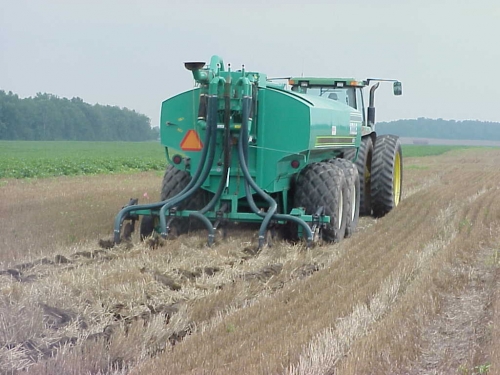Calibrate spreaders before manure is applied to wheat stubble
Spreading manure on wheat stubble provides a good time to calibrate spreaders and sample manure.
 Wheat and other small grain stubble provide a window of opportunity to apply manure when there is less worry about compaction and lower competition for time and equipment from other field activities. Utilize this time wisely to pull manure samples, check calibration and haul to fields with the lowest soil tests.
Wheat and other small grain stubble provide a window of opportunity to apply manure when there is less worry about compaction and lower competition for time and equipment from other field activities. Utilize this time wisely to pull manure samples, check calibration and haul to fields with the lowest soil tests.
It is expensive and time consuming to haul manure farther from the storage system, but those fields are most often the lowest in phosphorus and potassium. They will provide the greatest payback next spring when you DON’T have to buy so much fertilizer. Summer wheat stubble provides more time to haul manure to these fields than either the crunch time of spring planting or fall harvest. Pull out your soil tests and see where the manure can best be utilized (the lowest P and K test levels). If those fields are not in small grains this year, consider getting them into that rotation for following seasons.
Any chance you have, take a new manure sample. Summer may be less hectic and you’ll remember to pull a sample. One method is to collect a representative sample after all agitation and mixing and while loading out the manure spreader. Another method is to collect small samples in a larger container as the manure storage is being emptied then fill the sample container from this large composite sample. For the final sample, fill a plastic bottle three fourths full, put it in the freezer and remember to mail it to a lab early the next week. This analysis will provide current results for calibrating the manure application that should be used the next time the manure storage is emptied.
Summer can also provide a chance to double check the calibration of the spreader and adjust the application rate as needed to match the nutrient content of the manure with the needs of the field and future crop. Keep records of manure applications, rates, loads and documentation of calibration.
Although the soil may be hard and dry in late summer, injecting or incorporating manure is always better than broadcasting, especially when the weather is warm and odors tend to linger. In addition, neighbors are more sensitive to manure odors in the summer when windows are open and they are outside more. There are low disturbance tillage systems and newer vertical tillage systems that still leave plenty of residue while increasing the infiltration of manure reducing odor and retaining nutrients.
The nitrogen component comprises a third to a half of the economic value of manure. Lacking conservation practices, the manure nitrogen applied in late summer will leach through the soil profile or volatize off before next year’s crop N demand. Consider establishing cover crops, delaying manure application until after soils cool down or both, to retain manure N for next year’s crop.
Tiled fields, especially clay soils that may crack, need special observation and precautions. On tile drained fields, monitor tile outlets prior, during, and after manure applications and keep records of your observations. If manure is reaching tile lines, cease application immediately, stop the flow into the ditch and report the release to the Michigan Department of Environmental Quality (MDEQ). Assess why the manure is reaching tile lines and make a plan to avert the problem in the future. Reducing rates, and/or using soil tillage that disrupts pore spaces, may eliminate the problem but can only be validated by continued monitoring. If soil is excessively dry and cracked, tillage and waiting until the soil is rewetted by rain may be the only options to avert a release to surface waters.
All livestock farms in the state should be following Michigan’s Generally Accepted Agricultural and Management Practices (GAAMPS) for Manure Management and Utilization as published by the Michigan Department of Agriculture and Resource Development (MDARD). The GAAMPS can be found here. Manure GAAMPS require a manure management systems plan (MMSP) be in place on livestock farms to ensure proper use of all manure and to provide the farm nuisance protection from neighborhood complaints. Many farms may already have a comprehensive nutrient management plan (CNMP) which would fulfill the Right to Farm needs plus permitting requirements for large concentrated animal feeding operations.



 Print
Print Email
Email


